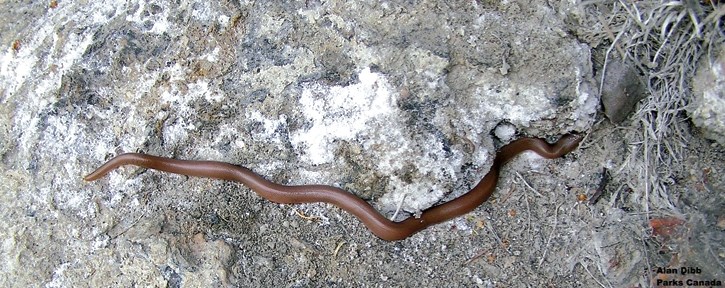It’s not the sexiest of Kootenay National Park’s wildlife, but a small snake found here is starting to get some attention.
The northern rubber boa has recently been confirmed by the Committee of the Status of Endangered Wildlife in Canada (COSEWIC) as a species of special concern because of ongoing threats from human activity.
Wildlife specialists with Parks Canada say the rubber boa likes to hang out near the hot springs in Radium in the southern end of Kootenay National Park – the northern end of the snake’s range in British Columbia.
“They are found in the vicinity of the hot springs,” said Seth Cherry, wildlife ecologist for Lake Louise, Yoho and Kootenay.
“We think they like that area based on thermal activity from the hot springs. It’s possible it’s the heat from the hot springs that they’re attracted to.”
Although very small at just 30 to 80 centimetres long, these snakes are in the same family as massive boa constrictors and pythons. They’ve never been known to bite, but do leave a smelly musk on people if handled roughly.
With a head and tail that look similar, the rubber boa has been dubbed the two-headed snake.
It’s thought the head-like tail may serve to distract predators as there have been reports of boas coiling up and performing fake strikes with their tails, or fending off a mother mouse with its blunt, club-like tail while devouring baby mice.
The snake is mostly active at night when it likes to hunt and feed.
Cherry said rubber boas are secretive and hard to find so not much is known about their populations.
He said Parks Canada keeps tracks of all observations that get reported, but there is no active monitoring project.
“They are very cryptic species and we don’t have a really good handle on their distribution,” said Cherry.
“They are a very difficult species to count. They tend to spend a lot of time burrowing under woody debris, rocks and boulders, so you don’t often see them.”
British Columbia is the northern limit of the rubber boa’s range in North America. There is one record of a rubber boa in Quesnel, B.C. and they also occur in dry southern interior valleys.
Female rubber boas give birth to two to eight young in August or September and clutches may be as infrequent as every four years. Even a productive female will not have a clutch every year. They can live to be more than 30 years old.
Scientists with COSEWIC say this makes them vulnerable to human activity.
Biologist Kristiina Ovaska said while the boa is relatively widely distributed in the southern half of B.C., with concentrations in the interior valleys, it could become threatened if threats to local populations are not sufficiently managed.
She said there are inferred declines in mature individuals based on habitat trends, and some subpopulations continue to be threatened by habitat loss and fragmentation, mainly from housing developments, roads and transport corridors.
“The snakes’ life history traits, including low reproductive rate, delayed age at maturity, and longevity, and specific habitat requirements for hibernation and thermo-regulation, make it sensitive to human activities,” said Ovaska.
Ovaska added it’s also important to protect hibernacula of the rubber boa.
“Hibernacula where they overwinter is of particular interest because they can attract many, many snakes and you have these concentrations so it’s important to protect them,” he said.
“There are some reports of 20-plus snakes together, so it’s not huge, huge concentrations like for other species, but there is communal hibernation, especially in colder climates like Radium.”
Cherry said Parks Canada has done some work in the Redstreak area around foundations of older buildings by putting in large rocks and covering them with woody debris in an effort to create snake habitat.




